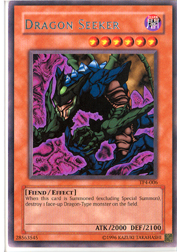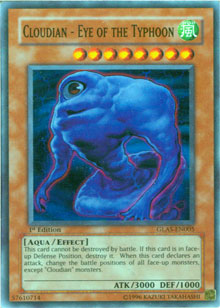Mandatory trigger effects are usually the easiest to understand because they don’t have any tricky timing to worry about. You only need to recognize that the "event" has occurred and then place the effect on the chain at the proper time. Trigger effects are spell speed 1 and thus find themselves at the beginning of the chain. We will explore the chain in more detail later.
Let’s look at a few monster cards with mandatory trigger effects:
"When this card is Tribute Summoned, destroy 1 monster on the field."
The "event" Zaborg is looking for is his own tribute summon. When this event occurs, his effect to destroy one monster on the field activates and you select your target. This effect will only activate when Zaborg is tribute summoned and won’t activate when you flip summon him or special summon him. If you reduce his level to 4 or less and normal summon him without tributes, his effect will not activate because he has not been tribute summoned.
Night Assailant:
"When this card is sent directly from your hand to the Graveyard, return 1 Flip Effect Monster from your Graveyard to your hand."
Night Assailant actually has two effects: a flip effect and a separate trigger effect. The trigger effect is activated when Night Assailant is sent from your hand to the graveyard, however you manage to do it. When you discard it to pay a cost or as a result of Card Destruction, its effect activates. When you send it to the graveyard to pay the activation cost of Darklord Zerato, its effect activates.
Newdoria: "When this card is destroyed and sent to the Graveyard as a result of battle, destroy 1 monster on the field."
Newdoria must be destroyed in battle and it must be sent to the graveyard. If it is removed from play instead (say with something like Macro Cosmos or Dimensional Fissure), its trigger effect will not activate. When Newdoria is destroyed by a card effect, its trigger effect won’t activate. When it attacks Sasuke Samurai #4 and Sasuke’s effect destroys it, the trigger effect won’t activate because Newdoria was destroyed by a card’s effect and not because Sasuke defeated it in battle.
Mandatory Trigger Effects and the Chain
When the proper event occurs, a mandatory trigger effect will activate and start a chain. If multiple mandatory trigger effects are triggered by the same event, they will activate their effects simultaneously and form a chain according to the rules for simultaneous effects. Other effects can then be chained, as long as their timing is appropriate.
Mandatory trigger effects that are triggered when a monster is summoned, manually changes its battle position, or declares an attack will normally begin a chain right away.

Example 1: Dragon Seeker
Example 2: Sangan and Hero Signal
Player A has Sangan in defense position and Hero Signal set in his spell and trap card zone. Player B attacks and destroys Sangan. At the end of the damage step, Sangan’s trigger effect activates when it is sent to the graveyard. Player A chains Hero Signal.
When the chain resolves, Hero Signal special summons Elemental Hero Ocean in attack position and Player A adds Elemental Hero Wildheart from his deck to his hand.
Example 3: Caius and Stumbling
Player A tribute summons Caius the Shadow Monarch while Player B has Stumbling in her spell and trap card zone. The trigger effects of Caius the Shadow Monarch and Stumbling activate at the same time, so the chain is built following the rules for simultaneous effects. Player A is the turn player, so his effect becomes chain link 1. Player B’s effect becomes chain link 2.
When the chain resolves, Stumbling shifts Caius the Shadow Monarch into defense position and then Caius removes his target from play.
 Example 4: Eye of the Typhoon vs. Vengeful Shinobi
Example 4: Eye of the Typhoon vs. Vengeful ShinobiWhen the chain resolves, Player B draws one card with Vengeful Shinobi’s effect and then Cloudian - Eye of the Typhoon shifts him into defense position.
Since trigger effects look for specific events, it is very possible that the event can occur while a chain is being built or while a chain is resolving. When this happens, the mandatory trigger effect will want to activate, but you don’t apply its effect right away. Mandatory trigger effects will wait until the current chain finishes resolving. Once the chain has resolved, they will begin a new chain and add their effects at the beginning of it.
Example 1: Doomed Assailant
Example 3: Blessings and Disasters
Player A activates Mystical Space Typhoon, targeting Player B’s face-down Fuh-Rin-Ka-Zan. Player B has Elemental Mistress Doriado, so she chains it. When the chain resolves, she makes Player A discard two cards at random. Player A discards Elephant Statue of Disaster and Elephant Statue of Blessing. Both effects want to activate, but they must wait until the chain finishes resolving. Next, Mystical Space Typhoon destroys Fuh-Rin-Ka-Zan.
Now that the chain has finished resolving, the effects of each Elephant start a chain. Since both cards were discarded by the same effect, their effects activate simultaneously. Player A decides how they are ordered on the chain.
Things get decidedly more complicated when multiple mandatory trigger effects are triggered by different events within the same chain. In this situation the rules of "simultaneous effects" can become a tad skewed. Sometimes the trigger effects will activate because of separate effects on the chain or because one of them was used as a cost and the others were hit by the resolving effect. It can be a tough concept to visualize, so let’s check out a few examples.

Example 1: Cost vs. Effect
When the chain resolves, Raigeki Break destroys Card Trooper, activating Card Trooper’s effect. We have two effects that need to be placed onto the chain, but the event for these effects did not happen simultaneously. Night Assailant’s event occurred first, when it was discarded, and Card Trooper’s effect occurred next, when it was destroyed by Raigeki Break. Night Assailant must be placed first onto the chain, followed by Card Trooper at chain link 2.
If the effects had been simultaneous, the chain would have been reversed, with Card Trooper at chain link 1 and Night Assailant at chain link 2.
Example 2: First One, Then The Other
Player A has Grandmaster of the Six Samurai in attack position and Player B has Granadora in attack position. Player A attacks Granadora with Grandmaster of the Six Samurai. Player B activates Sakuretsu Armor and Player A chains Raigeki Break and targets the Granadora.
When the chain resolves, Granadora is destroyed first, followed by Grandmaster of the Six Samurai. Each card is destroyed by a separate effect, so their effects are not simultaneous. Granadora’s effect is triggered first because it was destroyed first, so its effect is placed first on the following chain, with Grandmaster of the Six Samurai at chain link 2.
Example 3: Tribute My Opponent’s Sangan
Player A has Player B’s Sangan equipped with Snatch Steal. He tributes it to tribute summon Thestalos the Firestorm Monarch. In this situation, Sangan’s effect triggers first when it is tributed to summon Thestalos. Thestalos’s effect triggers next, when he is successfully tribute summoned. These two effects are not triggered simultaneously. The first triggered effect (Sangan) becomes chain link 1 and the next triggered effect (Thestalos) becomes chain link 2.
What if the Sangan was actually Player A’s Sangan? If this had been the case, the chain would be built in exactly the same way.
Next week, we will conclude our look at mandatory trigger effects and begin our examination of optional trigger effects. Until next time, send all comments and questions to Curtis@Metagame.com.